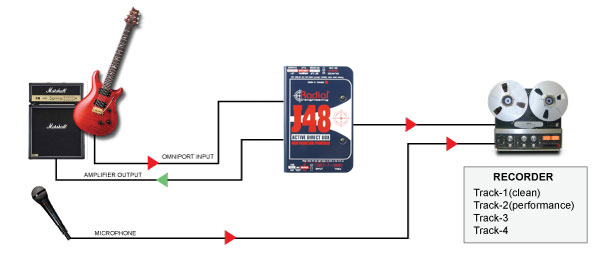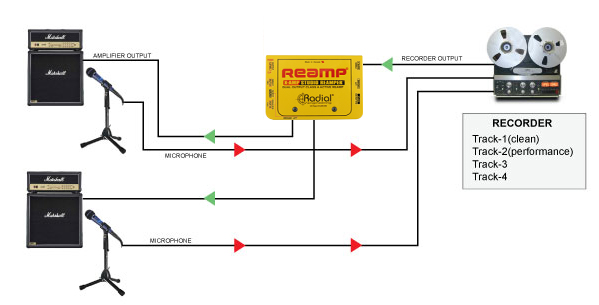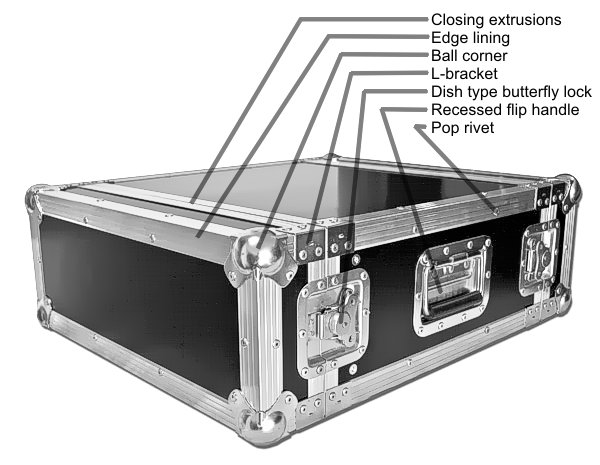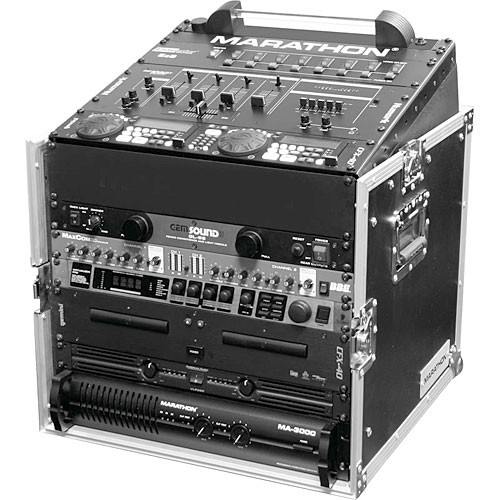Accessories
The end section of the ProGear guide is titled "Accessories". It is a collection of items that didn't fit elsewhere and are mostly small boxes that can be added to a gig bag or the cases that larger items are transported in.
Power Conditioning
"Any device with a primary function to condition the quality of commercial power received by a load. Sometimes also referred to as a line conditioner, a power conditioner typically provides protection against surges and spikes in power. Most power conditioners also provide basic EMI and RFI filtering by use of suppression circuits which keep such spurious signals out of audio circuits – provided it comes in on the AC line. Spikes and surges can damage your equipment. And while EMI (electromagnetic interference) and RFI (radio frequency interference) will not usually damage your equipment, they can cause unpredictable and unacceptable fleeting noises and – if strong enough – ruin a recording or performance."—From Sweetwater InSync
Power conditioners provide more protection than what you get in the average multiplug power strip. They do a better job of surge protection and add noise filtering. Some simple power strips have some degree of surge protection, but if the surge is too large the units may fail. In the best case a simple power strip will burn out and just need to be replaced. However, sometimes it continues to pass the high voltage on to the audio equipment which can cause damage or even fire.
You may have noticed static on your TV screen when you turn on a vacuum cleaner. That is noise being transmitted through the electrical lines in your house. Noise can also get into your audio equipment. Noise filters in power conditioners separate the outlets so that the electrical noise created by your computer doesn't get into your audio interface.
Some power conditioners also have voltage regulation so that your system gets a steady 120V. Furman, a brand of Nortek headquartered in Providence, RI, is one of the leading manufacturers of power conditioners used by musicians.
Little Boxes
The little boxes in the back of the ProGear guide have specialized functions beyond what a standard DI box has.
ART makes a number of different small boxes that offer solutions for audio needs such as phantom power, adding a couple of extra channels, testing cables, and premaps for headphones and turntables.
Switchcraft, Rupert Neve, Whirlwind, Radial, and Samson make boxes that do what a DI box does but with an extra feature or two, such as allowing you to connect an mp3 player, splitting an audio signal into multiple destinations, converting a laptop's output to mic level, engage different EQ curves, pad, accept amp level signals, operate in stereo, etc.
Re-Amping
"Reamping is a two stage process whereby you first record a dry or clean track and then re-record the track afterwards by sending the clean tract back through your amps and effects.
The benefits with Reamping are tremendous: From the musician's perspective, the best performance is usually captured when the artist is fresh. Before Reamping, the guitarist would have to play for hours while the engineers moved mics in effort to find the perfect sound. By the time the engineer is ready to record, the guitarist is tired and is more prone to errors."—Radial website
Reamping step 1 - recording the dry signal from the DI box on one track and the sound of the amp through a microphone on a second track.
Reamping step 2 - playing the DI recorded sound back through the amp. Now you can experiment with amplifier settings and cabinet and microphone placement.
Another thing to consider, however, is that a performer will play differently if they are inspired by the sound they are producing, and skilled performers adjust what they play to the effects that are being produced. If you record with a dry DI signal they may not play with the same intensity that they do when they hear a guitar amp cranked and distorting, for example. On the other hand, recording with a mic on a cabinet and simultaneously the DI signal on a second track gives you the option of later going back and processing the dry signal in an endless number of ways, including reamping.
Lighting
Often times a touring band uses whatever a venue has to offer rather than carrying their own system. It's good to prepared, though, and have an understanding of the issues and what to ask for, have a system ready to go when necessary, and/or have a relationship with a lighting company who can take over that part of the production. The industry is moving towards LED lights which are cheaper, cooler, use less power, have more color options, and can be remotely controlled.
From Sweetwater Lighting guide:
How To Build Your Perfect Lighting Setup
It's easy to forget how important good lighting is to a live performance - until the house lights accidentally switch on, or the stage lights blow a fuse. Lighting is a huge part of how we consume live events - whether we're at an underground rock show, or the Metropolitan Opera. DJs and set designers alike rely on proper lighting to visually enhance and refine their productions. We've luckily come a long way from the 1600s, when stages were lit by candles and chandeliers! Today's performers can choose from an endless variety of sophisticated lighting gear. It's never been easier - or more affordable - to dazzle audiences of any size.
The Basics
Stage lighting isn't only for DJs and touring musicians. Virtually any live venue can benefit from a professional light setup: lecture halls, theaters, churches, conference halls, clubs, museums, etc. And depending on the setting, lighting can be simple - with only a few units - or it can include a complex network of strobes, lasers, and other effects. Regardless of size, every lighting system includes controllers, stands, mounts, cables, and the lights themselves. Think of lighting as the visual equivalent of a PA system.
Spotlights
Lighting - like speakers - come in a huge variety of size, function, and power. Spotlights are the quintessential stage light, found in venues of every size. Traditionally, spotlights were aimed and operated manually, but nowadays most can be operated and focused remotely. Spotlights are especially useful for highlighting individuals onstage, or for projecting powerful, moving ovals of light at live shows. For example, the ADJ FS-1000 is a more traditional halogen "follow spot;" while the Chauvet DJ Intimidator Spot 355Z IRC is a 90-watt "intelligent" model, which means its head movements (and focus) are controlled remotely. The Intimidator is notable for its use of LED lighting, which requires far less power and generates virtually no heat, making the stage a more hospitable place.
PAR Cans
PAR cans - short for "parabolic aluminized reflector" lights - provide "flat" light, and do not move in the way spotlights do. (They can, of course, be manually adjusted). Par can lamps come in five different sizes, which project different size pools of light: very narrow spot, narrow spot, medium flood, wide flood, and extra-wide flood. For colored light, a color "gel" can be laid over the lamp. Or, a PAR might combine several small LED lights, capable of changing color without the use of gels. The Chauvet DJ SlimPAR Q12 is a great example: with 12 quad-color LEDs, and dual USB and infrared remote control compatibility.
Other Lights
For performers looking for a little more panache, Sweetwater also carries a variety of lasers, strobes, and other exciting effects. Strobe lights are known for their blinding, pulsing flash; the super-lightweight ADJ S81 LED II boasts 21 LEDs and 130-degree projection. While a spotlight shines a single oval light, lasers shoot out hundreds of thin, rotating beams of light. The Chauvet DJ Scorpion Storm FX RGB, for example, has 100-degree coverage, and comes with 255 lighting patterns built in. Other lights offer a more subtle ambiance: the ADJ Black-24BLB is a black light tube fixture, great for mood lighting in clubs, bars, and restaurants.
Controllers and Interfaces
There are three main ways to orchestrate and direct lighting fixtures. First, hand-held remote controls are model-specific, and allow users to adjust lights from a distance. For example, the Chauvet IRC-6 can adjust strobe rates, color, intensity, etc. with the click of a button - but only for certain Chauvet models. "Controllers" offer a second way to orchestrate light shows - take the ADJ DMX Controller, for example. Controllers look (and act) like mixing boards, and take DMX channels as inputs; the ADJ model can control up to 192 DMX channels. (DMX cables connect light fixtures to controllers and interfaces). Interfaces are a third option; they link DMX lighting fixtures into USB, so you can direct your lights with a computer. The ENTTEC DMXIS is a renowned lighting interface, ready to plug right into ENTTEC D-PRO2 Universe software.
Stands, Clamps, and Accessories
Even the most elaborate lighting fixtures can do little good if they're not wisely and securely installed. Stands like the ADJ Portable Lighting Tripod Stand offer a portable way to hoist up and stabilize light fixtures. Clamps like the ADJ Dura Clamp, or the Chauvet DJ CLP-05 Heavy-duty C-clamp, latch lights onto trusses and stands - whether they're 10 or 100 feet above an audience. The CLP Heavy-duty C-clamp, for example, can handle a load of up to 110 lbs. Sweetwater has everything you need to build your perfect light setup. We even carry extras like fog machines - check out ADJ's Fog Fury 1000. Whether you're an iconic venue, or a DJ just getting started, we can help you captivate any audience.
Cases
Many racks are designed to accommodate devices that are 19" wide—the industry standard for audio equipment. The equipment is screwed into rails, and the number of "U"s indicates how tall they are. For example, a "6U" case can hold six 1U devices, two 3U devices, or 3 2U devices, or any combinations therof.
Considerations include whether they are rated to go on airplanes and whether there are wheels or not. "Lids" close the front and back and sometimes the top to allow access to the controls in front and connectors in the back.
There are also cases for keyboards and other instruments, microphones, and every other type of audio product used in performances which protect the devices and allow them to be stacked during transport.
Gator is a major supplier of cases, with headquarters in Tampa, Florida and large manufacturing and distrubution center in Columbia City, Indiana.



